The CDF Canada group is involved in the following research projects:
Top Quark Physics
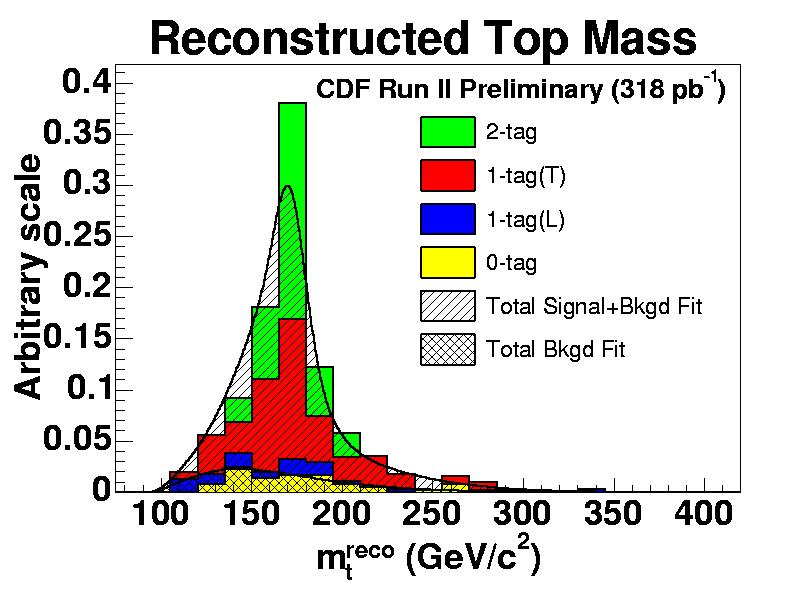 |
Top Quark Mass with In Situ Determination of the Jet Energy Scale
The top quark mass is a fundamental parameter of the Standard Model, and it,
along with the W boson mass,
constrains the Higgs boson mass. The mass is measured by selecting ttbar
events where one W boson decay leptonically and the other hadronically.
The observed invariant mass of the hadronic W boson decay is used to reduce
the largest systematic uncertainty arising from the jet energy scale. The
top quark mass and hadronic W boson mass distributions reconstructed in data
are compared to Monte Carlo expectations to determine simultaneously the top
quark mass and the jet energy scale. We measure M_top = 173.5 +3.7/-3.6
(stat.+JES) +/- 1.3 (syst.) GeV/c^2, where the first uncertainty includes
both the statistical and the jet energy scale (JES) uncertainty.
This constitutes the best measurement of the top quark mass to date.
|
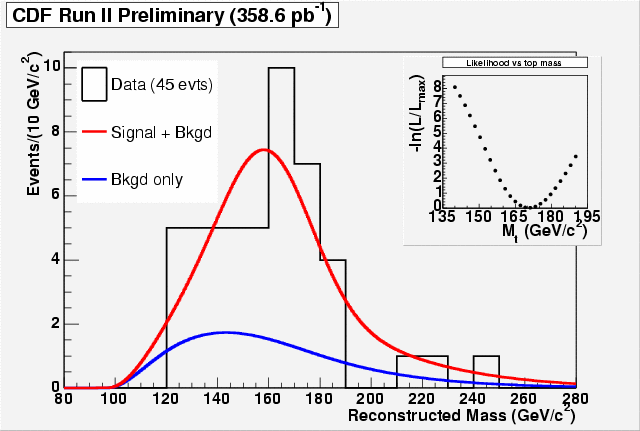 |
Top Quark Mass Measurements in the Dilepton Channel using the Neutrino Weighting Algorithm
The measurement of the top quark mass (with the measurement of the W
boson mass) constrains the prediction of the Higgs boson mass. If the Higgs
boson is discovered, this will allow a self-consistency test of the
Standard Model. To measure of the Top Quark Mass
we select top candidates that are consistent with two
W bosons decaying to a charged lepton and a neutrino. Only one of the
two charged leptons is required to be identified as an electron or a muon
candidate, while the other is simply a well measured track. We use an
algorithm that weighs each possibility of neutrino direction to
reconstruct a top quark mass in each event. We compare the resulting
distribution to Monte Carlo templates to obtain the top quark mass.
|
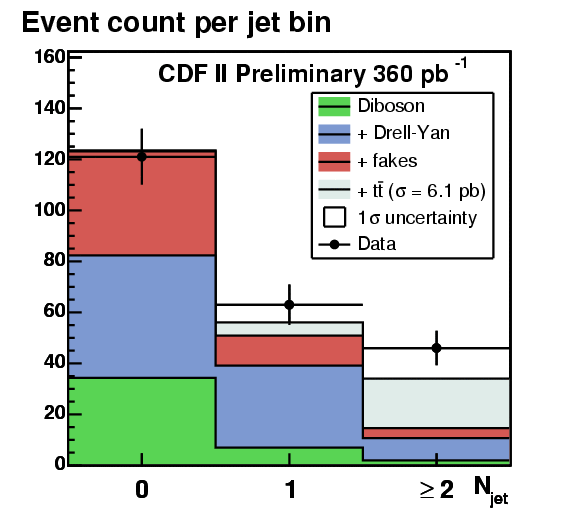 |
Top Quark Pair Production Cross Section using Lepton + Isolated Track Selection
Top decays via the dilepton channel have fewer background counts
compared to other channels. But this channel suffers from a low branching
ratio, which limits its statistical power. The lepton + isolated track
selection increases acceptance to single prong hadronic tau decays, and
leptons in uninsturmented regions of the detector by requiring
a well measured and energetically isolated track and a traditionally
identified lepton instead of two leptons. |
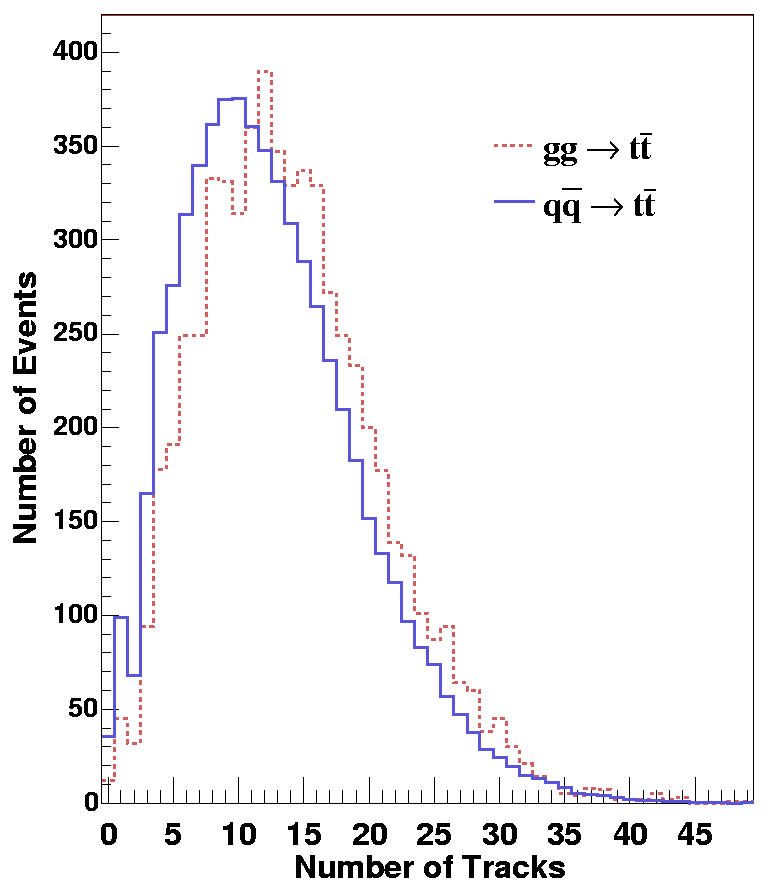 |
Study of Top Quark Pair Production Mechanisms
Top quark is the heaviest elementary particle observed and is perceived as
an important probe to understand the origin of the mass. Since its discovery
in 1995, there have been many studies to measure its mass, its production
rate and its other properties. According to the Standard Model, top quarks
are dominantly produced in pairs. The rate for the top quark pair (ttbar)
production have been measured, but the rate for ttbar production has not
been broken up to the rate for different mechanisms. Our analysis is the
first measurement of the contribution of gluon-gluon fusion (gg) to produce
top quark pairs over the contributions through quark-antiquark annihilation
(qqbar). In order to make this measurement, we must distinguish between the
two different processes for ttbar production. We take advantage of the fact
that it is more likely for gluons to radiate a gluon than it is for quarks
to do so. Therefore, we expect to see more particles in gg events than in
qqbar events. We use the distribution of low energy charged particles to
find the ratio of ttbar production through gg over ttbar production through
qqbar.
|
Electroweak Physics
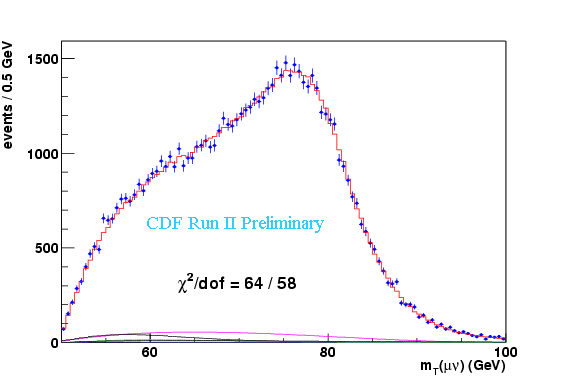 |
W Boson Mass
The W boson mass is a fundamental parameter of the Standard Model. Together
with the top quark mass, the W boson mass constrains the Higgs boson mass, which has not yet been
observed experimentally. We measure the W boson mass in the two clean leptonic decay channels
W->mu nu and W->e nu. The signature is a high energy lepton with large missing transverse energy
originating from the neutrino, which does not interact with the detector. The momentum balance
in the direction of the beam is unconstrained and as a result, we study the W events in the plane
transverse to the beam. A typically used quantity is the transverse mass, mT, which is similar
to the invariant mass, just in the two transverse dimensions. There are two important aspects to a
precise W boson mass measurement. Firstly, calibrating the detector to the highest possible level
and secondly a detailed simulation, including all relevant W production kinematics and detector effects.
|
QCD
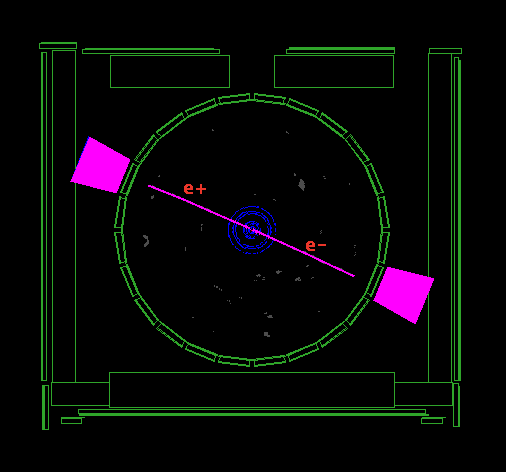 |
Search for Exclusive Processes
There are Standard Model processes in which hadrons do not dissociate in the
interaction. Without hadron dissociation there is no underlying event in
the interaction - only a very clean, exclusive, central system is observerd
in the detectror. We are searching for two exclusive processes; double
pomeron exchange to two photons, and photo-production of electron pairs.
Theoretically, the pomeron process can produce a Higgs Boson. If suitable
detectors are installed at the LHC, the outgoing protons can be used like a
spectrometer to measure the Higgs mass. Because the photo-production
process is governed by QED its cross section can be accurately calculated,
meaning that it could be a useful tool to measure the luminosity at the LHC.
Before either of these processes can be used at the LHC, they must be
understood here at the Tevatron - the goal of this research is to observe and
understand these unique events at CDF.
|
 |
Measurement of the Inclusive b-Jet Cross Section
The notion and discovery of "quarks" has revolutionized humankind's
understanding of physics at the most fundamental level. The "strong"
force that binds quarks together is described by the theory of Quantum
ChromoDynamics (QCD). In this analysis we test QCD by measuring the
production of bottom (b) quarks in highly energetic jets resulting from
proton-antiproton collisions at the Fermilab Tevatron, using the CDF-II
detector. The term "jet" refers to a spray of particles traveling in
roughly the same direction, all originating from a high-energy parent
particle. To detect b-quark jets we rely on the excellent particle
tracking resolution of CDF-II and an advanced "Jet Probability" analysis
algorithm to determine if the collection of particle tracks within a jet
are consistent with the decay of a b-quark. We compare our measurement to
the predictions of QCD theory.
|
Exotic Physics
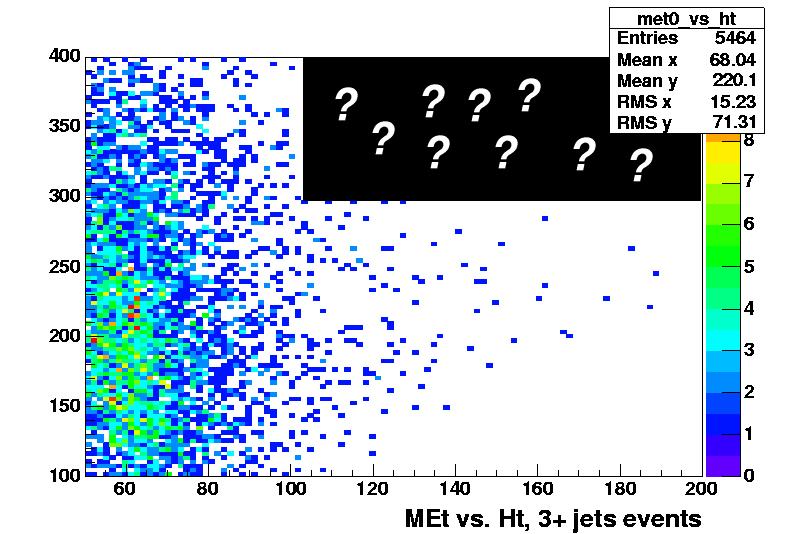 |
Seach for Supersymmetry in Missing Transverse Energy and Multi-jet Events
Supersymmetry (SUSY) is one of the most popular candidates for physics
beyond
the Standard Model. In supersymmetric theories, each Standard Model boson
has
a fermionic partner, and vice versa. The gluon's partner is called a
"gluino",
and the partners of the quarks are called "squarks". In one range of SUSY
theories, where the quantity R-parity is conserved, pair-produced squarks
and gluinos would decay, producing energetic hadronic jets and weakly
interacting stable "neutralinos". These neutralinos would escape detection
by
the CDF calorimeter, thus producing missing transverse energy (MET). In
this
search, a signal region with high MET and three or more energetic jets is
defined. The signal region is treated as a "blind box", and will not be
examined until the backgrounds to the signal are fully understood in nearby
control regions and the cuts on the data are optimized. As CDF has collected
more than four times the data so far in its second run as it did in its
first
run, when a similar search was performed, analysis of this data should
extend
existing limits on the squark and gluino masses, and thus on the fundamental
SUSY parameters.
|
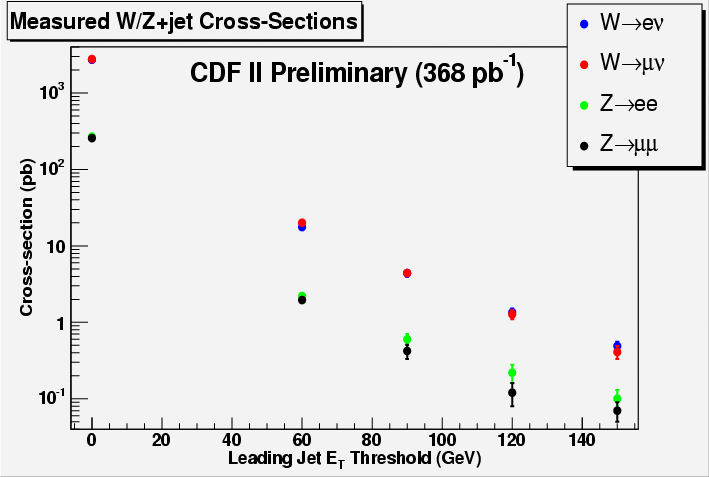 |
Search for Extra Dimensions in Jets + Missing Energy in Run II
In order to make sense of many fundamental aspects of the Universe such as
the quantum description of gravity, the origin of the mass of particles or
the the possible compositness of leptons and quarks, the so far successful
Standard Model (SM) of particle physics needs to be extended.
The observation of
an excess over the SM expectation in events with a mono-jet plus large
missing transverse energy topology would provide a clear signal of possible
new physics. In order to find such an excess, we first need to
estimate the number of Z(->nunu)+1-jet events that will be contained in our
data sample. This is deduced from the number of Z->ee, Z->mumu, W->enu and
W->munu plus 1-jet events that we count. We expect (including some less
important background events) a total of
265+/-30 SM events in our data sample and we observe 263. Thus no excess has
yet been found. From this we set a limit on the possibility of
observing a quantum of gravity (graviton) by setting a lower limit on the
Planck scale of a D-dimensional world (D in [6,10]).
|
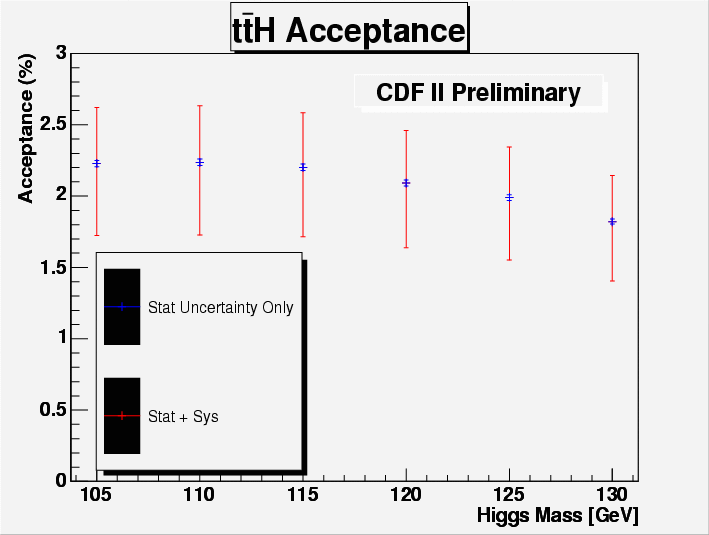 |
Search for Higgs Boson in ttH Events
Though predicted by the Standard Model as the key to electroweak symmetry
breaking, the Higgs boson has yet to be observed. The interaction strengths
of the Higgs boson with other particles is proportional to their mass. Thus
the channel ttH provides an interesting search channel for the Higgs boson
and additionally allows us to understand the mechanism that gives mass to
particles. Sensitivity to ttH requires lepton identification and efficient
identification of jets originating from b-quarks.
|
|














